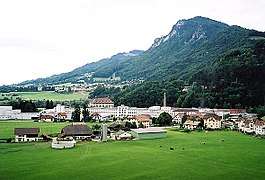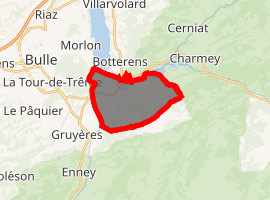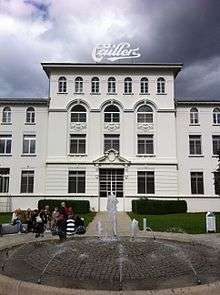Broc
Broc ([bʀɔ:], Arpitan: ![]()
Broc | |
|---|---|
 Broc village | |
 Coat of arms | |
Location of Broc 
| |
 Broc  Broc | |
| Coordinates: 46°36′N 7°6′E | |
| Country | Switzerland |
| Canton | Fribourg |
| District | Gruyère |
| Government | |
| • Mayor | Syndic |
| Area | |
| • Total | 10.06 km2 (3.88 sq mi) |
| Elevation | 718 m (2,356 ft) |
| Population (2018-12-31)[2] | |
| • Total | 2,651 |
| • Density | 260/km2 (680/sq mi) |
| Postal code | 1636 |
| SFOS number | 2124 |
| Surrounded by | Botterens, Châtel-sur-Montsalvens, Crésuz, Gruyères, La Tour-de-Trême, Morlon, Val-de-Charmey |
| Website | www SFSO statistics |
History
Broc is first mentioned in 1115 as Broc and Broch. The municipality was formerly known by its German name Bruck, but that name is no longer used.[3]
Geography

Broc has an area, as of 2009, of 10 square kilometers (3.9 sq mi). Of this area, 4.2 km2 (1.6 sq mi) or 41.8% is used for agricultural purposes, while 4.44 km2 (1.71 sq mi) or 44.2% is forested. Of the rest of the land, 0.91 km2 (0.35 sq mi) or 9.1% is settled (buildings or roads), 0.29 km2 (0.11 sq mi) or 2.9% is either rivers or lakes and 0.22 km2 (0.085 sq mi) or 2.2% is unproductive land.[4]
Of the built up area, housing and buildings made up 4.8% and transportation infrastructure made up 2.6%. Of the forested land, 42.2% of the total land area is heavily forested and 2.0% is covered with orchards or small clusters of trees. Of the agricultural land, 6.2% is used for growing crops, 20.6% is pastures and 14.8% is used for alpine pastures. Of the water in the municipality, 1.4% is in lakes and 1.5% is in rivers and streams.[4]
The municipality is located in the Greyerz district, on the Bulle-Boltigen road near the Jaun Pass.

Coat of arms
The blazon of the municipal coat of arms is Gules, a Crane Argent rising from a chevron-like Bridge Or and in chief dexter a Mullet of Five of the last.[5]
Demographics
Broc has a population (as of December 2018) of 2,651.[6] As of 2008, 25.4% of the population are resident foreign nationals.[7] Over the last 10 years (2000–2010) the population has changed at a rate of 8%. Migration accounted for 10%, while births and deaths accounted for 0.4%.[8]
Most of the population (as of 2000) speaks French (1,826 or 88.3%) as their first language, Portuguese is the second most common (60 or 2.9%) and German is the third (54 or 2.6%). There are 18 people who speak Italian.[9]
As of 2008, the population was 50.8% male and 49.2% female. The population was made up of 783 Swiss men (34.9% of the population) and 355 (15.8%) non-Swiss men. There were 845 Swiss women (37.7%) and 259 (11.6%) non-Swiss women.[10] Of the population in the municipality, 659 or about 31.9% were born in Broc and lived there in 2000. There were 746 or 36.1% who were born in the same canton, while 215 or 10.4% were born somewhere else in Switzerland, and 336 or 16.2% were born outside of Switzerland.[9]
As of 2000, children and teenagers (0–19 years old) make up 24.8% of the population, while adults (20–64 years old) make up 57.7% and seniors (over 64 years old) make up 17.5%.[8]
As of 2000, 821 people were single and never married in the municipality, 1,000 married individuals, 159 widows or widowers, and 88 individuals who are divorced.[9]
As of 2000, there were 826 private households in the municipality, and an average of 2.4 persons per household.[8] There were 288 households that consist of only one person and 59 households with five or more people. In 2000, a total of 819 apartments (85.1% of the total) were permanently occupied, while 73 apartments (7.6%) were seasonally occupied and 70 apartments (7.3%) were empty.[11] As of 2009, the construction rate of new housing units was 5.4 new units per 1000 residents.[8] The vacancy rate for the municipality, in 2010, was 0.29%.[8]
The historical population is given in the following chart:[3][12]

Heritage sites of national significance
The Barrage De Montsalvens (shared with Châtel-sur-Montsalvens), and the Notre-Dame des Marches Chapel are listed as Swiss heritage sites of national significance. The Broc-Fabrique and Broc-Vieille Cure areas are both part of the Inventory of Swiss Heritage Sites.[13]
 Barrage De Montsalvens
Barrage De Montsalvens
Politics
In the 2011 federal election, the most popular party was the SP, which received 29.9% of the vote. The next three most popular parties were the SVP (21.0%), the CVP (20.7%) and the FDP (15.8%).[14]
The SPS received about the same percentage of the vote as they did in the 2007 Federal election (28.6% in 2007 vs 29.9% in 2011). The SVP moved from fourth in 2007 (with 18.6%) to second in 2011, the CVP moved from second in 2007 (with 24.9%) to third and the FDP moved from third in 2007 (with 19.5%) to fourth. A total of 615 votes were cast in this election, of which 13 or 2.1% were invalid.[15]
Economy

As of 2010, Broc had an unemployment rate of 4.5%. As of 2008; there were 23 people employed in the primary economic sector and about 9 businesses involved in this sector; 481 people were employed in the secondary sector and there were 19 businesses in this sector. 292 people were employed in the tertiary sector, with 48 businesses in this sector.[8] There were 970 residents of the municipality who were employed in some capacity, of which females made up 42.2% of the workforce.
In 2008 the total number of full-time equivalent jobs was 698. The number of jobs in the primary sector was 18, of which 15 were in agriculture and 3 were in forestry or lumber production. The number of jobs in the secondary sector was 465 of which 415 or (89.2%) were in manufacturing and 19 (4.1%) were in construction. The number of jobs in the tertiary sector was 215. In the tertiary sector; 55 or 25.6% were in wholesale or retail sales or the repair of motor vehicles, 8 or 3.7% were in the movement and storage of goods, 38 or 17.7% were in a hotel or restaurant, 1 was in the information industry, 1 was the insurance or financial industry, 16 or 7.4% were in education and 56 or 26.0% were in health care.[16]
In 2000, there were 592 workers who commuted into the municipality and 592 workers who commuted away. The municipality is a net exporter of workers, with about 1.0 workers leaving the municipality for every one entering.[17] Of the working population, 9.5% used public transportation to get to work, and 67.6% used a private car.[8]
Religion
From the 2000 census, 1,662 or 80.4% were Roman Catholic, while 86 or 4.2% belonged to the Swiss Reformed Church. Of the rest of the population, there were 9 members of an Orthodox church (or about 0.44% of the population), there was 1 individual who belongs to the Christian Catholic Church, and there were 36 individuals (or about 1.74% of the population) who belonged to another Christian church. There were 67 (or about 3.24% of the population) who were Islamic. There were 13 individuals who were Buddhist, 3 individuals who were Hindu and 3 individuals who belonged to another church. 73 (or about 3.53% of the population) belonged to no church, are agnostic or atheist, and 131 individuals (or about 6.33% of the population) did not answer the question.[9]
Education
In Broc about 615 or (29.7%) of the population have completed non-mandatory upper secondary education, and 150 or (7.3%) have completed additional higher education (either university or a Fachhochschule). Of the 150 who completed tertiary schooling, 65.3% were Swiss men, 22.7% were Swiss women, 8.0% were non-Swiss men and 4.0% were non-Swiss women.[9]
The Canton of Fribourg school system provides one year of non-obligatory Kindergarten, followed by six years of Primary school. This is followed by three years of obligatory lower Secondary school where the students are separated according to ability and aptitude. Following the lower Secondary students may attend a three or four year optional upper Secondary school. The upper Secondary school is divided into gymnasium (university preparatory) and vocational programs. After they finish the upper Secondary program, students may choose to attend a Tertiary school or continue their apprenticeship.[18]
During the 2010-11 school year, there were a total of 274 students attending 14 classes in Broc. A total of 426 students from the municipality attended any school, either in the municipality or outside of it. There were 4 kindergarten classes with a total of 79 students in the municipality. The municipality had 10 primary classes and 195 students. During the same year, there were no lower secondary classes in the municipality, but 84 students attended lower secondary school in a neighboring municipality. There were no upper Secondary classes or vocational classes, but there were 29 upper Secondary students and 69 upper Secondary vocational students who attended classes in another municipality. The municipality had no non-university Tertiary classes, but there were 5 non-university Tertiary students and 10 specialized Tertiary students who attended classes in another municipality.[10]
As of 2000, there were 40 students in Broc who came from another municipality, while 160 residents attended schools outside the municipality.[17]
References
- "Arealstatistik Standard - Gemeinden nach 4 Hauptbereichen". Federal Statistical Office. Retrieved 13 January 2019.
- "Ständige Wohnbevölkerung nach Staatsangehörigkeitskategorie Geschlecht und Gemeinde; Provisorische Jahresergebnisse; 2018". Federal Statistical Office. 9 April 2019. Retrieved 11 April 2019.
- Broc in German, French and Italian in the online Historical Dictionary of Switzerland.
- Swiss Federal Statistical Office-Land Use Statistics 2009 data (in German) accessed 25 March 2010
- Flags of the World.com accessed 21-November-2011
- Swiss Federal Statistical Office - STAT-TAB, online database – Ständige und nichtständige Wohnbevölkerung nach institutionellen Gliederungen, Geburtsort und Staatsangehörigkeit (in German) accessed 23 September 2019
- Swiss Federal Statistical Office - Superweb database - Gemeinde Statistics 1981-2008 Archived June 28, 2010, at the Wayback Machine (in German) accessed 19 June 2010
- Swiss Federal Statistical Office Archived January 5, 2016, at the Wayback Machine accessed 21-November-2011
- STAT-TAB Datenwürfel für Thema 40.3 - 2000 Archived August 9, 2013, at the Wayback Machine (in German) accessed 2 February 2011
- Canton of Fribourg Statistics (in German) accessed 3 November 2011
- Swiss Federal Statistical Office STAT-TAB - Datenwürfel für Thema 09.2 - Gebäude und Wohnungen Archived September 7, 2014, at the Wayback Machine (in German) accessed 28 January 2011
- Swiss Federal Statistical Office STAT-TAB Bevölkerungsentwicklung nach Region, 1850-2000 Archived September 30, 2014, at the Wayback Machine (in German) accessed 29 January 2011
- "Kantonsliste A-Objekte". KGS Inventar (in German). Federal Office of Civil Protection. 2009. Archived from the original on 28 June 2010. Retrieved 25 April 2011.
- Canton of Fribourg National Council Election of 23 October 2011 Statistics Archived 2012-04-05 at the Wayback Machine (in German and French) accessed 3 November 2011
- Swiss Federal Statistical Office, Nationalratswahlen 2007: Stärke der Parteien und Wahlbeteiligung, nach Gemeinden/Bezirk/Canton Archived May 14, 2015, at the Wayback Machine (in German) accessed 28 May 2010
- Swiss Federal Statistical Office STAT-TAB Betriebszählung: Arbeitsstätten nach Gemeinde und NOGA 2008 (Abschnitte), Sektoren 1-3 Archived December 25, 2014, at the Wayback Machine (in German) accessed 28 January 2011
- Swiss Federal Statistical Office - Statweb (in German) accessed 24 June 2010
- Chart of the education system in Canton Fribourg (in German)
| Wikimedia Commons has media related to Broc. |